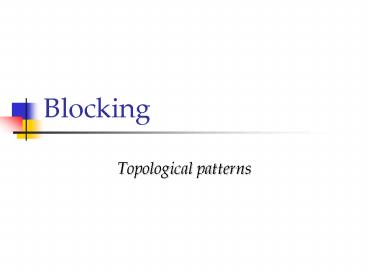Blocking - PowerPoint PPT Presentation
1 / 48
Title:
Blocking
Description:
the valency theme ( government) the illocutionary ... Bilbo. OR. MR. DR. OI. L. W. s. v. F. Subject in F (blocked S) BLOCKING CAUSED BY MOVEMENT TO FUNDAMENT ... – PowerPoint PPT presentation
Number of Views:533
Avg rating:3.0/5.0
Title: Blocking
1
Blocking
- Topological patterns
2
Blocking is caused by
- the form of the predicate
- the valency theme ( government)
- the illocutionary frame
- constituent movements and shifts
3
Three types of slots
- Filled slots
- Blocked slots
- Empty slots
- - a) Facultative arguments
- - b) Ellipsis
- - c) Satellites (adverbials)
4
Revised sentence schemes
- Erik Hansens verbal schemes (1970)
- Lars Heltofts declarative and neutral schemes
combined scheme (1986 ?) - Ole Togebys combined scheme (2003)
- Henrik Jørgensens analysis of clitic pronominals
her and der (1991 ?)
5
Hansens verbals schemes
- A verb has a valency theme with slots not only
for nominals and adverbials, but also for other
verbs. - These governed verbs have sentence schemes of
their own, similar to those of subordinated
sentences.
6
Hansens verbal schemes
Ex. (Jeg tror ikke) at jeg ville have kunnet
indhente rytteren
7
Heltofts sentence scheme
8
The predicative category
Manner adverbials
The predicative category
9
Togebys sentence scheme
Manner adverbials
Incorporated predicates
10
The nuclear predication
ARGUMENTS
CO-PREDICATE
CO-PREDICATE
HOST-PREDICATE
THE CORPORATE PREDICATE
11
Intransitive verbs
12
Syntactic government
SYN.GOV.
13
Semantic government
SYN.GOV.
SEM.GOV.
14
Predicate blocking
SYN.GOV.
SEM.GOV.
PREDICATE BLOCKING
15
Valency blocking
SYN.GOV.
SEM.GOV.
PREDICATE BLOCKING
VALENCY BLOCKING
16
Mono-valent corporate predicates
- Predicate blocking MR
- Valency theme Monovalent
- Argument blocking OI, DR (MR) and OR
17
Transitive verbs type a
- Valency theme Divalent (type a)
- Argument blocking OI, (MR) and OR
18
Transitive verbs type b
- Valency theme Divalent (type b)
- Argument blocking OI, DR and (MR)
BLOCKED BY WEIGHT SHIFT
BLOCKED BY WEIGHT SHIFT
19
Transitive verbs
I) Active construction
G-ROLE agent E-ROLE
patient
20
Transitive verbs
II) Passive construction
E-ROLE patient
PASSIVE BLOCKING
21
Ergative verbs
I) Transitive construction
G-ROLE agent E-ROLE patient
22
Ergative verbs
II) Intransitive construction
E-ROLE patient
ERGATIVE BLOCKING
23
Causative predicates
BLOCKED BY DATIVE SHIFT
BLOCKED BY DATIVE SHIFT
24
V2-movement
BLOCKED BY V2-MOVEMENT
25
Subject in F (blocked S)
BLOCKING CAUSED BY MOVEMENT TO FUNDAMENT
26
Direct object in F (blocked DR)
BLOCKING CAUSED BY MOVEMENT TO FUNDAMENT
27
Indirect object in F (blocked IO)
BLOCKING CAUSED BY MOVEMENT TO FUNDAMENT
28
Preposition stranding
29
Provisional subject in F
ANNULMENT OF VALENCY BLOCKING
30
Infinite verb arguments in F (blocked
predication field)
BLOCKED BY MOVEMENT OF INFINITE VERB ARGUMENTS
TO F
31
Frame blocking
- Blocked v in Danish marks non-realis (question,
imperative, condition, comparison subordinated
non-realis sentences) - (!) Note In Heltofts scheme non-realis is
marked by an - empty fundament.
32
Non-realis frame (blocked v)
Ex. Har Danmark ikke vundet kampen, bliver jeg
sur (condition)
BLOCKED BY THE ILLOCUTIONARY FRAME
33
Non-realis frame (blocked v)
Ex. Han græd som var han pisket (comparison)
BLOCKED BY THE ILLOCUTIONARY FRAME
34
Non-realis frame (blocked v)
Ex. Har ungerne spist kagen? (interrogative)
BLOCKED BY THE ILLOCUTIONARY FRAME
35
Non-realis frame (blocked v)
Ex. Spis du bare kagen (imperative)
BLOCKED BY THE ILLOCUTIONARY FRAME
36
Non-realis frame (blocked v (and F))
Ex.Det var rart, at han ikke var sur
(sub-ordinated sentences in non-realis)
BLOCKED BY THE ILLOCUTIONARY FRAME
37
Argument shifts
- Based upon Jørgensens theory
- A light pronominal ( her and der) moving left is
placed in the slot of the first argument or
predicate element that it encounters, blocking
the slot it moved from.
38
Argument shifts
39
Argument shifts
Blocked by argument shift
40
Argument shifts
Blocked by argument shifts
41
Argument shifts
Blocked by argument shifts
42
Argument shifts
Blocked by argument shifts
43
Object stranding
Sten Vikner (2005) has suggested that some
non-finite transitive verbs can be moved to the
fundament in a topicalised position without their
arguments, leaving the object stranded Ex.
Kysset har jeg hende ikke, bare holdt hende i
hånden.
44
Object stranding
I have tried to find other examples of these
types of strandings, but I have not been able to
find any in Korpus 2000/90, BySoc or in a tagged
search for verbal auxiliaries left of the finite
verb funcAUXgt in VISL. However,
after going all Google-eyes, I finally found some
examples of object stranding, but only for verbs
that governs sentence equivalent objects. These
strandings may be allowed due to the weight
(and perhaps extra position) of the object and
are therefore not similar to Vikners example.
45
Object stranding
- Glemt har jeg at i Onsdags da jeg følte mig syg
kom en Søn af afdøde biskop Münster og bad om at
turde føre til mig en skolebestyrerinde fra
Königsberg - H.C. Andersen, Diaries 1868-1870
- Helt glemt har sønderjyderne nok ikke nederlaget
tilbage i november mod Herning. - http//hockeymania.dk
- Helt misforstået har du dog det med Skåne,
Halland og Blekinge. - From a Danish blog
46
Object stranding
Vikner 2005 Lånt hende har jeg den ikke, jeg har
faktisk givet hende den
VIOLATION?
47
The pronominal mixture
Jeg har skam ikke lånt-hende, thi hun er min
egen hustru! Hik!
Lånt-hende har-jeg-den ikke
Derfor har-jeg-den ikke til låns.
48
Questions and comments
- Now for your
- questions and comments.
- and thank you very much for listening!































